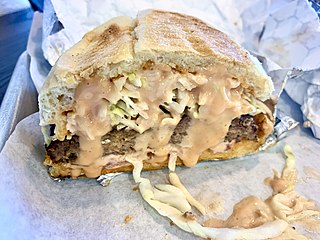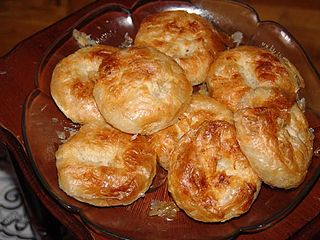
This is a list of notable grape dishes and foods that are prepared using grapes as a primary ingredient. Raisin dishes and foods are also included in this article.

This is a list of notable grape dishes and foods that are prepared using grapes as a primary ingredient. Raisin dishes and foods are also included in this article.


A grape is a fruit, botanically a berry, of the deciduous woody vines of the flowering plant genus Vitis .

A raisin is a dried grape. [5] Raisins are produced in many regions of the world and may be eaten raw or used in cooking, baking, and brewing.

Dessert is a course that concludes a meal. The course consists of sweet foods, such as cake, biscuit, ice cream and possibly a beverage such as dessert wine and liqueur. Some cultures sweeten foods that are more commonly savory to create desserts. In some parts of the world there is no tradition of a dessert course to conclude a meal.

New England cuisine is an American cuisine which originated in the New England region of the United States, and traces its roots to traditional English cuisine and Native American cuisine of the Abenaki, Narragansett, Niantic, Wabanaki, Wampanoag, and other native peoples. It also includes influences from Irish, French-Canadian, Italian, and Portuguese cuisine, among others. It is characterized by extensive use of potatoes, beans, dairy products and seafood, resulting from its historical reliance on its seaports and fishing industry. Corn, the major crop historically grown by Native American tribes in New England, continues to be grown in all New England states, primarily as sweet corn although flint corn is grown as well. It is traditionally used in hasty puddings, cornbreads and corn chowders.

Russian cuisine is a collection of the different dishes and cooking traditions of the Russian people as well as a list of culinary products popular in Russia, with most names being known since pre-Soviet times, coming from all kinds of social circles.

Jewish cuisine refers to the worldwide cooking traditions of the Jewish people. During its evolution over the course of many centuries, it has been shaped by Jewish dietary laws (kashrut), Jewish festivals and holidays, and traditions centred around Shabbat. Jewish cuisine is influenced by the economics, agriculture, and culinary traditions of the many countries where Jewish communities have settled and varies widely throughout the entire world.

Pecan pie is a pie of pecan nuts mixed with a filling of eggs, butter and sugar. Variations may include white or brown sugar, cane syrup, sugar syrup, molasses, maple syrup, or honey. It is commonly served at holiday meals in the United States and is considered a specialty of Southern U.S. origin. Most pecan pie recipes include salt and vanilla as flavorings. Pecan pie may be served with whipped cream, vanilla ice cream or hard sauce.

Salvadoran cuisine is a style of cooking derived from the nation of El Salvador. The indigenous foods consist of a mix of Amerindian cuisine from groups such as the Lenca, Pipil, Maya Poqomam, Maya Chʼortiʼ, Alaguilac and Cacaopera peoples. Many of the dishes are made with maize (corn). There is also heavy use of pork and seafood. European ingredients were incorporated after the Spanish conquest.

Iraqi cuisine is a Middle Eastern cuisine that has its origins in the ancient Near East culture of the fertile crescent. Tablets found in ancient ruins in Iraq show recipes prepared in the temples during religious festivals—the first cookbooks in the world. Ancient Mesopotamia was home to a sophisticated and highly advanced civilization, in all fields of knowledge, including the culinary arts.

Dominican cuisine is made up of Spanish, indigenous Taíno, Middle Eastern, and African influences. The most recent influences in Dominican cuisine are from the British West Indies and China.

Egyptian cuisine makes heavy use of poultry, legumes, vegetables and fruit from Egypt's rich Nile Valley and Delta. Examples of Egyptian dishes include rice-stuffed vegetables and grape leaves, hummus, falafel, shawarma, kebab and kofta. Others include ful medames, mashed fava beans; koshary, lentils and pasta; and molokhiyya, bush okra stew. A local type of pita bread known as eish baladi is a staple of Egyptian cuisine, and cheesemaking in Egypt dates back to the First Dynasty of Egypt, with Domiati being the most popular type of cheese consumed today.

Sephardic cuisine is the traditional cuisine of Jews who lived in the Iberian Peninsula until their expulsion in the late 15th century. After their expulsion, many Sephardic Jews settled in various parts of the Ottoman Empire, North Africa, and the Mediterranean.

Israeli cuisine primarily comprises dishes brought from the Jewish diaspora, and has more recently been defined by the development of a notable fusion cuisine characterized by the mixing of Jewish cuisine and Arab cuisine. It also blends together the culinary traditions of the various diaspora groups, namely those of Middle Eastern Jews with roots in Southwest Asia and North Africa, Sephardi Jews from Iberia, and Ashkenazi Jews from Central and Eastern Europe.

Vincotto is a dark, sweet, thick paste produced in rural areas of Italy. It is made by the slow cooking and reduction over many hours of non-fermented grape must until it has been reduced to about one-fifth of its original volume and the sugars present have caramelized. It can be made from a number of varieties of local red wine grapes, including Primitivo, Negroamaro and Malvasia Nera, and before the grapes are picked they are allowed to wither naturally on the vine for about thirty days. In Roman times it was known as sapa in Latin and epsima in Greek, the same names that are often used for it in Italy and Cyprus, respectively, today.

Mizrahi Jewish cuisine is an assortment of cooking traditions that developed among the Mizrahi Jewish communities of the Middle East, North Africa and Central Asia. Influenced by the diverse local culinary practices of countries such as Morocco, Libya, Egypt, Iraq, Iran, Yemen, and Syria, Mizrahi cuisine prominently features rice, legumes, meats, and an array of spices such as cumin, turmeric, and coriander. Signature dishes include kubbeh (dumplings), pilafs, grilled meats, and stews like hamin.

Grape syrup is a condiment made with concentrated grape juice. It is thick and sweet because of its high ratio of sugar to water. Grape syrup is made by boiling grapes, removing their skins, squeezing them through a sieve to extract the juice. Like other fruit syrups, a common use of grape syrup is as a topping to sweet cakes, such as pancakes or waffles.

This is a categorically organized list of foods. Food is any substance consumed to provide nutritional support for the body. It is produced either by plants, animals, or fungi, and contains essential nutrients, such as carbohydrates, fats, proteins, vitamins, and minerals. The substance is ingested by an organism and assimilated by the organism's cells in an effort to produce energy, maintain life, or stimulate growth.

Middle Eastern cuisine or West Asian cuisine includes a number of cuisines from the Middle East. Common ingredients include olives and olive oil, pitas, honey, sesame seeds, dates, sumac, chickpeas, mint, rice and parsley, and popular dishes include kebabs, dolmas, falafel, baklava, yogurt, doner kebab, shawarma and mulukhiyah.